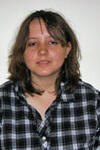Ana Malagon
Dark matter plays an important role in structure formation and composes 26.8% of the total energy density in the universe. There are many postulated particles that are theorized to be the constituents of cold dark matter; however, none have been observed experimentally. One strongly motivated particle that could be cold dark matter is the axion, a pseudoscalar with a two photon vertex. Experimental techniques to detect dark matter axions rely on a multiphoton radiative transition; in the presence of a strong magnetic field axions can convert to photons. If a microwave cavity is placed in the interaction region, when the produced photon’s frequency is resonant with a mode of the cavity, the signal power is enhanced further. As the axion mass is not known, the resonant frequency of the cavity must be swept to search for possible converted photons. We present here the first microwave cavity search for dark matter axions with masses near 140 microeV. The experiment measured the power in the Ka-band frequency range from a cryogenically cooled cavity in a 7 Tesla background magnetic field. We took data for six months and swept the microwave cavity resonant frequency from 33.9-34.5 GHz, corresponding to an axion mass range of 140.2-142.7 microeV. We did not observe any statistically significant signals, and thus placed an upper bound on the axion to two photon coupling of $g_{a\gamma\gamma} < 8.75 \times10^{-11}$ 1/GeV. With the same data set we were also able to set new limits on dark matter “hidden photon”-photon interactions of $\chi < 5\times10^{-10}$. Hidden photons are postulated massive vector bosons that would only interact with Standard Model photons, and arise from new gauge extensions to the Standard Model.
